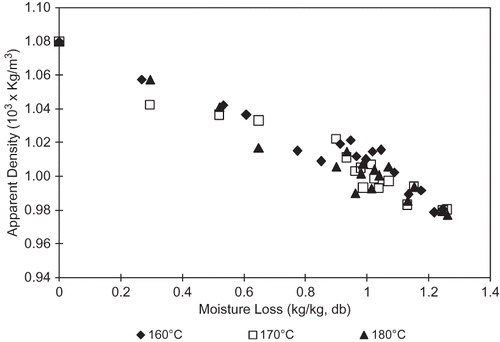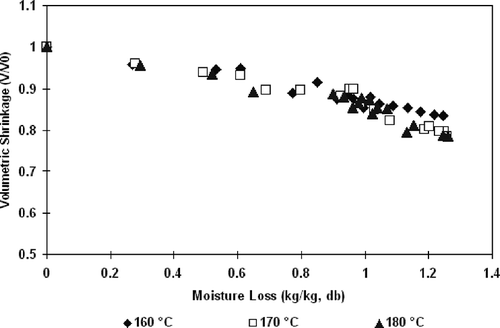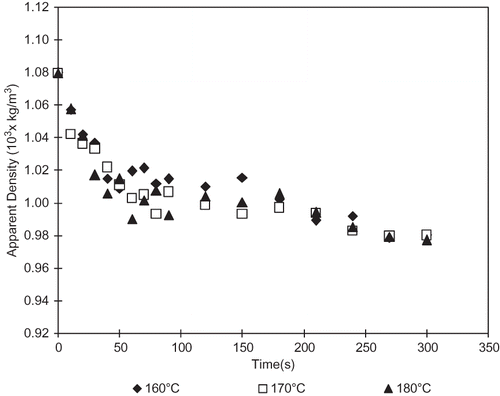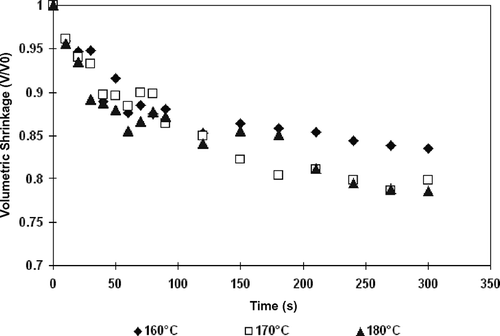Abstract
Apparent density and apparent volume shrinkage of chicken nuggets were analyzed at three frying temperatures (160, 170, and 180°C) at 16 time intervals between 0 and 300 s. A linear relation was found for particle densities with moisture loss. Apparent density decreased from about 1080 to 980 kg/m3 during frying. The regression of volumetric shrinkage as a function of moisture loss gave coefficient of determination value (R2) values ranging between 0.90 and 0.94. Temperature effect on apparent density was not significant, while its effect on shrinkage was quite pronounce (P < 0.05). The influence of moisture loss, frying time and temperature on density and shrinkage during deep-fat frying of chicken nuggets was established.
INTRODUCTION
Deep-fat frying is an important food processing operation that involves heat and mass transfer that induce structural changes such as shrinkage. Shrinkage is very important in characterizing the structure of processed food.[Citation1] Shrinkage is a normal phenomenon for products during deep-fat frying. It is defined as change in volume caused by moisture loss, reduction of pores, protein denaturation and the likes that occur during food processing such as frying. Most foods, because of high initial moisture content, will undergo considerable shrinkage during frying. Rahman and Perera[Citation2] reported that shrinkage in a direction parallel to the muscle fibers is significantly different from that perpendicular to the fiber direction. Volume changes are dependent on several factors such as geometry, experimental conditions and drying methods.[Citation3–5] Rahman[Citation6] reported that shrinkage influences porosity change during thermal processing and is dependent on initial moisture content, composition and size of food materials, type of drying (freeze-dried or air dried) and drying conditions such as temperature and relative humidity. Moreira and Sereno[Citation7] showed that volumetric shrinkages could be estimated based on the change in moisture content of a sample, independent of drying rate. Therefore, determination of the volumetric shrinkage could provide an indirect indication of change in product's characteristics with moisture content.
Shrinkage and density are mass-volume related properties widely used in the modeling of transport phenomena.[Citation8] Density can be measured by the pycnometric method. Ngadi et al.[Citation9] used a pycnometer to measure the skeletal density of meat patties extended with soy protein. Shrinkage in meat products is usually anisotropic. Madamba et al.[Citation10] reported shrinkage of biological materials to be based on their fiber-orientation and anisotropic structure. Since this leads to shape irregularity as shrinkage proceeds, shrinkage was therefore determined by the volume displacement method rather than by just dimensional measurement. The objective of this study was to evaluate the relationship between moisture loss and volumetric shrinkage of chicken nuggets during deep-fat frying in order to predict shrinkage.
MATERIALS AND METHODS
Materials
Frozen chicken nuggets were obtained from a major local producer (Olymel, Montreal, QC). The mean weight of the nuggets was about 21 ± 2 g. The dimension of the commercial samples was about 5 × 3.7 × 1.2 (± 0.2 cm). The coating layer thickness was approximately 0.1 cm. The samples were thawed in the refrigerator at 4°C for 24 h before use.
Frying Operation
An industrial deep-fat fryer was used (Computron 7000, Henny Penny Corp., Eaton, Ohio). The fryer had a capacity of about 30 liters. Hydrogenated canola oil purchased from a local supplier (Canbra Foods Ltd., Lethbridge, AB) was used in all the frying runs. The fresh oil was preheated and maintained at 160, 170, or 180 ± 2°C for 2 h before the nuggets were fried.
Moisture Analysis
Chicken nugget samples were fried at 16 different time intervals between 0 and 300 s at three levels of different temperatures (160, 170, and 180°C). Each chicken nugget was considered as an individual sample. For each frying run, three chicken nugget samples were placed on a frying basket and fried in the fryer. After frying, the nuggets were immediately withdrawn from oil, and were blotted gently with dry tissue paper to remove any excess oil on the surface. The whole samples were weighed and then dried to a constant weight in a convection oven (Isotemp 700, Fisher Scientific, Pittsburgh, PA) for 24 h at an oven temperature of 105°C.[Citation11] The samples were placed in a desiccator to cool down, then weighed and the moisture content determined by difference in weight on a dry weight basis (db).
Density and Shrinkage
Apparent density of the samples was measured using the liquid displacement technique with water.[Citation12] The volume displacement (Archimedes) pycnometer consists of two compartments namely bulb and stem. The dimension of the pycnometer is 2.78 cm diameter by 10 cm length for the pycnometer bulb, 1.5 cm diameter by 22 cm length for the stem of the pycnometer. The pycnometer was filled with water and the samples were immersed in the top compartment and sealed. When turned upside down the displaced volume was determined. The volume was first measured without the samples and the second time with the samples immersed in the liquid, and the volume reading was done as quickly as a possible (<15 s) to avoid moisture absorption. The volume displacement was calculated based on the following relationship (EquationEq. 1):
Where Vs is the volume of the samples (cm3); Vf is the final volume of with the samples immersed in the liquid (cm3); and Vi is the initial volume without the samples (cm3). Shrinkage was determined as the ratio of volume change to the initial volume.
Statistical Analysis
The data were analyzed using SAS software (Version 8.2, 1999, SAS Institute Inc., Cary, NC, USA). Duncan's multiple range test (DMRT) was used to estimate differences among the means at 5% level of significance.
RESULTS AND DISCUSSION
The relationship between apparent density and frying time at different frying temperatures is shown in . Apparent density decreased from about 1080 to 980 kg/m3during frying from 0 to 300 s at three different frying temperatures. Analysis of variance (ANOVA) results show that oil temperature did not influence the density changes significantly (P < 0.05) but frying time significantly influenced it. The mean apparent density from DMRT results was 1012 kg/m3 after 300 s of frying at all the temperatures. High frying time resulting in a lower apparent density may be related to the shrinkage and pore formation.[Citation13] Rahman et al.[Citation14] also obtained similar result in drying of fish muscles. Taiwo and Baik[Citation15] in their study on sweet potato showed similar trend for apparent density. They attributed the reduced decrease in density after the initial high rate of decrease to quick formation of crust on the surface.
Apparent density decreased as moisture loss increased. Statistical analysis shows that there was no significant influence (P < 0.05) of temperature on apparent density change during frying. shows the relationship between apparent density and moisture loss at different oil temperatures during deep-fat frying of chicken nuggets. Wang et al.[Citation16] also got similar results in studying the density of potato during dehydration. Garayo and Moreira[Citation17] also reported a similar result for volumetric shrinkage of potato chips during the early stages of frying to be almost equal to the volume of moisture loss. A regression equation of apparent density as a function of moisture was developed as given in EquationEq. (2):
Figure 2 Relationship between apparent density and moisture loss during deep-fat frying of chicken nuggets.

The relationship between volumetric shrinkage and frying time at different frying oil temperatures are shown in . ANOVA results show that the volume changed with frying time, and frying temperature significantly, (P < 0.05) influenced the volumetric shrinkage. The mean comparisons of the effect of oil temperature show that although the mean shrinkage was not significantly different at the frying oil temperatures of 170 and 180°C, there were significant difference at the lower oil temperature (160°C). The chicken nuggets shrank in volume with time asymptotically by up to about 18% during the 300 s frying period.
The relationship between shrinkage and moisture loss was almost linear as shown in . Giri and Prasad[Citation19] also reported similar result for mushroom drying. listed the regression equations for volumetric shrinkage as a function of moisture loss for chicken nuggets in deep-fat frying process. Shrinkage increased with moisture loss. The linear equations could be used to predict the volumetric shrinkage during frying. Kassama and Ngadi[Citation20] also obtained a linear relationship between volumetric shrinkage and moisture loss during frying of chicken meat though with a lower R2 value of approximately 0.82.
Figure 4 Volumetric shrinkage as a function of moisture loss during deep-fat frying of chicken nuggets.

Table 1 Regression equations for volumetric shrinkage as a function of moisture loss for coated chicken nuggets in deep-fat frying
CONCLUSION
Frying oil temperature and time both had significant influence (P < 0.05) on the food mass-volume related properties of fried chicken nuggets such as apparent bulk density and volumetric shrinkage during the frying process. Apparent density decreased significantly with an increase in frying time but not obviously with an increase in frying oil temperature. A linear relation was established between apparent densities and moisture loss. Conversely, the volumetric shrinkage increased with the increase of frying oil temperature and frying time. The relationship between volumetric shrinkage and moisture loss was also found to be almost linear and the linear equation may be useful in predicting the volumetric shrinkage during frying.
ACKNOWLEDGMENT
The authors will like to acknowledge the funding support of Natural Science and Engineering Research Council (NSERC) of Canada.
REFERENCES
- Boukouvalas , C. J. , Krokida , M.K. , Maroulis , Z.B. and Marinos-Kouris , D. 2006 . Density and porosity: literature data compilation for foodstuffs . International Journal of Food Properties , 9 : 715 – 746 .
- Rahman , M.S and Perera , C.O. 1999 . “ Drying and food preservation ” . In Handbook of food preservation , Edited by: Rahman , M.S. 173 – 216 . New York : Marcel Dekker . InEd. bypp.
- Moreira , R. , Figureueiredo , A.M. and Sereno , A.M. 2000 . Shrinkage of apple disks during drying by warm air convection and freeze drying . Drying Technology , 18 ( 1&2 ) : 279 – 294 .
- McMinn , W.A.M. and Magee , T.R.A. 1997 . Quality and physical structure of dehydrated starch-based systems . Drying Technology , 15 ( 6–8 ) : 1961 – 1971 .
- Krokida , M.K. , Oreopoulou , V. and Maroulis , Z.B. 2000 . Effect of frying condition on shrinkage and porosity of fried potatoes . Journal of Food Engineering , 43 : 147 – 154 .
- Rahman , M.S. 2001 . Towards prediction of porosity in foods during drying: A Brief Review . Drying Technology , 19 ( 1 ) : 1 – 13 .
- Moreira , R. and Sereno , A.M. 2003 . Evaluation of mass transfer coefficients and volumetric shrinkage during osmotic dehydration of apple using sucrose solutions in static and non-static conditions . Journal of Food Engineering , 57 : 25 – 31 .
- Baik , O.D. and Mittal , G.S. 2005 . Heat and moisture transfer and shrinkage simulation of deep-fat tofu frying . Food Research International , 38 : 183 – 191 .
- Ngadi , M.O. , Kassama , L.S. and Raghavan , G.S.V. 2001 . Porosity and pore size distribution in cooked meat patties containing soy protein . Canadian Biosystems Engineering , 43 ( 3 ) : 17 – 24 .
- Madamba , P.S. , Driscoll , R.H. and Buckle , K.A. 1994 . Shrinkage, density and porosity of garlic during drying . Journal of Food Engineering , 23 : 309 – 319 .
- AOAC 950.46 . 1990 . Official Methods of Analysis , 931 Washington, DC : Association of Official Analytical Chemists .
- Kassama , L.S. and Ngadi , M.O. 2005 . Pore development and moisture transfer in chicken meat during deep-fat frying . Drying Technology , 23 : 1 – 27 .
- Rahman , M.S. 2003 . A theoretical model to predict the formation of pores in foods during drying . International Journal of Food Properties , 6 : 61 – 72 .
- Rahman , M.S. , Perera , C.O. , Chen , X.D. , Driscoll , R.H. and Potliri , P.L. 1996 . Density shrinkage, and porosity of calamari mantle meat during air-drying in a cabinet dryer as a function of water content . Journal of Food Engineering , 30 : 135 – 145 .
- Taiwo , K.A. and Baik , O.D. 2007 . Effects of pre-treatments on the shrinkage and textural properties of fried sweet potatoes . LWT—Food Science and Technology , 40 : 661 – 668 .
- Wang , N. and Brennan , J.G. 1995 . Changes in structure, density and porosity of potato during dehydration . Journal of Food Engineering , 24 : 61 – 76 .
- Garayo , J. and Moreira , R.G. 2002 . Vacuum frying of potato chips . Journal of Food Engineering , 55 : 181 – 191 .
- Balaban , M. and Pigott , G.M. 1986 . Shrinkage in fish muscle during drying . Journal of Food Science , 51 ( 2 ) : 510 – 511 .
- Giri , S.K and Prasad , S. 2006 . modeling shrinkage and density changes during microwave-vacuum drying of button mushroom . International Journal of Food Properties , 9 : 409 – 419 .
- Kassama , L.S. and Ngadi , M.O. 2003 . Density, shrinkage and porosity of deep-fat fried chicken meat . Proceedings of American Society of Agricultural Engineers (ASAE) . July 27–30 2003 , Las Vegas. Paper no. 036107

